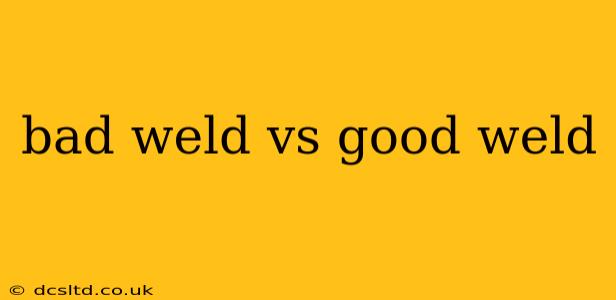Welding is a crucial process in numerous industries, from construction and manufacturing to automotive and aerospace. The quality of a weld directly impacts the safety and longevity of the final product. Distinguishing between a bad weld and a good weld is essential for ensuring structural integrity and preventing costly repairs or catastrophic failures. This guide will delve into the key differences, focusing on visual inspection and understanding common weld defects.
What are the Visual Differences Between a Good and Bad Weld?
A good weld exhibits several key characteristics:
- Consistent bead appearance: The weld bead should be smooth, uniform, and free from excessive porosity (small holes), cracks, or undercuts (grooves along the weld's edge).
- Proper penetration: The weld should fully penetrate the base material, creating a solid fusion between the two pieces. This ensures the joint's strength and prevents weakness.
- Absence of defects: A good weld is free from visible flaws such as slag inclusions (trapped debris), spatter (metal droplets), or undercut.
- Correct reinforcement: The weld bead should have appropriate reinforcement—a slight buildup of weld material—but not excessive, which can indicate poor control.
- Consistent color: The color should be uniform throughout, indicating proper fusion and heat input. Discoloration can suggest overheating or other problems.
Conversely, a bad weld shows several warning signs:
- Porosity: Numerous small holes indicate gas entrapment during welding.
- Cracks: These are serious defects that weaken the weld and can lead to failure. They may be surface cracks or internal cracks, both requiring immediate attention.
- Undercutting: Grooves along the weld edges show insufficient fusion to the base material.
- Incomplete penetration: A lack of fusion between the base materials leaves a weakened joint.
- Excessive spatter: Excessive spatter indicates poor welding technique and can also weaken the weld.
- Slag inclusions: Trapped slag (molten flux) creates weak points in the weld.
- Burn-through: A hole going completely through the base material indicates excessive heat input.
- Lack of fusion: The weld metal didn't properly fuse with the base metal, creating a weak joint.
How Can I Tell if a Weld is Bad? (Common Questions)
Here are answers to some frequently asked questions about identifying bad welds:
What are some common signs of a poor weld?
Common signs include porosity (small holes), cracks, incomplete penetration, excessive spatter, slag inclusions, undercutting, and burn-through. These visual defects can significantly reduce the weld's strength and durability.
How can I identify a cracked weld?
Cracks can be subtle, appearing as fine lines or fissures on the surface or within the weld bead. Sometimes, they are only detectable with advanced inspection methods like dye penetrant testing or magnetic particle inspection. Visual inspection can reveal larger, more pronounced cracks.
What causes porosity in welds?
Porosity is often caused by gas entrapment during the welding process. This can be due to insufficient purging of gases from the weld area, contaminated filler material, or improper welding techniques.
What does incomplete penetration mean in welding?
Incomplete penetration means the weld didn't fully fuse the base materials. This leaves a weak point in the joint, prone to failure under stress. Visual inspection, often combined with cross-sectional viewing, is crucial for detecting this defect.
How do I prevent bad welds?
Prevention involves proper training and adherence to established welding procedures. This includes using appropriate materials, maintaining equipment, employing correct welding techniques, and using appropriate pre- and post-weld inspections.
Beyond Visual Inspection: Advanced Techniques for Weld Evaluation
While visual inspection is the first line of defense, advanced techniques are often necessary for thorough weld evaluation. These include:
- Radiographic testing (RT): Detects internal flaws such as cracks, porosity, and inclusions.
- Ultrasonic testing (UT): Uses sound waves to identify internal defects.
- Magnetic particle testing (MT): Detects surface and near-surface cracks in ferromagnetic materials.
- Dye penetrant testing (PT): Detects surface-breaking cracks and other defects.
The choice of testing method depends on the weld's application and the potential risks of failure.
By understanding the visual characteristics of good and bad welds, and employing appropriate inspection techniques, you can significantly improve the quality, safety, and reliability of welded structures. Remember, prevention is always better than cure. Proper training, careful welding practices, and regular inspections are paramount in avoiding costly repairs and potential disasters.
